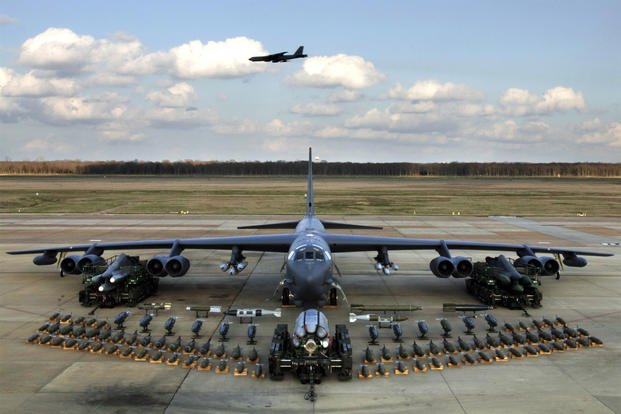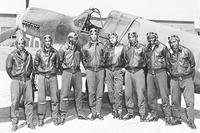Defense Department officials may select a bomber already in the Air Force's inventory to become its munitions-packed "arsenal plane," Dr. Will Roper, Assistant Secretary of the Air Force for Acquisition, Technology and Logistics, said Tuesday.
Roper told reporters in Washington, D.C. that the service has a vision for its current bomber fleet, which constitutes turning the bomber force -- the B-52 Stratofortress, B-1 Lancer or B-2 Spirit -- into "something else" in the future.
Hypothetically, a B-52 loaded with multiple hypersonic weapons can evolve from its standard function into a "missileer," Roper said.
The acquisition chief said the service has been working with the Air Force Global Strike Command on hypersonic weapons tests on the B-52. The Air Force in June flew its first test flight of the AGM-183A Air Launched Rapid Response Weapon, a hypersonic weapon known as ARRW (pronounced "Arrow").
Related: Air Force Planning Shorter, More Frequent Strategic Bomber Rotations
"[But] can we think more broadly about how an airplane carrying a lot of weapons can be looked at?" Roper said. "[For example], how does this standoff bomber work in the contested environment in a way that's complementary with the [penetrating] B-21 [Raider]?"
In 1995, the U.S. Navy and the Defense Advanced Research Projects Agency first conceived of the mobile arsenal concept as a ship that would have a limited crew but and as many as 500 vertical launch tubes for missiles to provide ship-to-shore bombardment. In 2016, then-Defense Secretary Ash Carter debuted the idea for an "arsenal plane" in an effort to make more aircraft multifunctional and relevant to the fight. The initiative has been under the purview of the Strategic Capabilities Office.
Then-Air Force Secretary Deborah Lee James that same year showed a rendering of what an arsenal plane might look like.
It's not the first time the service has considered repurposing its bombers -- and companies have been willing to throw out some additional ideas.
For example, last year, the service posted a public request for information to identify contractors that could offer insights on how to best integrate newer and much heavier bombs under the B-52's wings.
While specific munitions weren't advertised for the 'Heavy Weapon Release Pylon Program' RFI, the Air Force at the time was looking to at least quadruple the bomb size, according to the solicitation.
Similarly, Boeing Co. last year proposed turning the B-1B into a gunship -- sort of.
The company was granted a patent for a cannon that could enhance the aircraft's ability to take on more close-air support roles.
Depictions showed various mounts for the gun -- corresponding to a machine gun, a chain gun, a cannon, an autocannon, a rail gun, a projectile firing device or a laser weapon -- that would retract into the aircraft's belly. The company shared these ideas with the service, a Boeing spokeswoman said at the time.
In September, AFGSC's Gen. Tim Ray announced that the Air Force the previous month proved it can transform the Lancer to hold more ordnance -- a step that may pave the way to future hypersonic weapons payloads for the presently non-nuclear bomber.
In test with the 419th Flight Test Squadron, Edwards Air Force Base, California, teams demonstrated how crews could fasten new racks onto the external hardpoints of the B-1, and reconfigure its internal bomb bays to hold heavier weapons.
"The conversation we're having now is how we take that bomb bay [and] put four, potentially eight, large hypersonic weapons on there," Ray said during the annual Air Force Association Air Space and Cyber conference.
"Certainly, the ability to put more JASSM-ER [Joint Air-to-Surface Standoff Missile Extended Range] or LRASM [Long Range Anti-Ship Missile] externally on the hardpoints as we open those up. So there's a lot more we can do," he said, as reported by Defense News.
Roper on Tuesday said in keeping with tradition of not limiting the Air Force to one idea, there are "a lot of other systems that are out there, even some outside of the Air Force" that could potentially make a future arsenal plane.
Some experts have suggested that could include the C-17 Globemaster III or even older C-130 Hercules transport aircraft.
"If the arsenal plane is intended to carry air-to-ground weapons, then they could deploy from the rear ramp of mobility platforms, which would not require extensive modifications," Todd Harrison, director of the Aerospace Security Project for Center for Strategic and International Studies, recently told Air Force Magazine.
Harrison noted, however, the B-52 'Big Ugly Fat Fellow' may be best for the job.
"An arsenal plane does not necessarily need to be stealthy or fast, but it needs to have a large payload capacity," he told the magazine.
--Richard Sisk contributed to this report.
-- Oriana Pawlyk can be reached at oriana.pawlyk@military.com. Follow her on Twitter at @oriana0214













